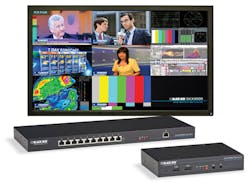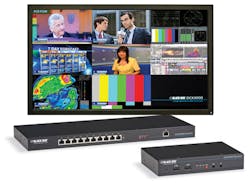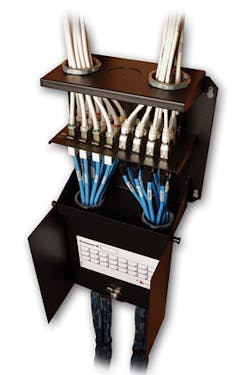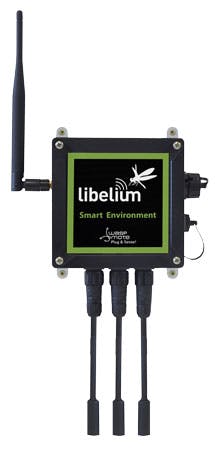Editor's Picks
Digital KVM matrix switch from Black Box enables HD video, audio, USB sharing among 30 control-room users
Black Box recently announced the release of its DCX3000, a high-performance digital KVM matrix switch. The DCX3000 delivers fast switching of HD video, audio and USB across a combination of 30 sources and end users. Broadcast applications include live production studios, outside broadcast vehicles (OBV) and post-production. Additional applications include control rooms for public safety, transportation, military, process control and manufacturing, utilities and air traffic control.
The DCX3000 system contains three components: the central switching unit (DCX3000), the receiver unit (DCX3000-DVR), and server access modules (DVI, DCX3000-DVT; DisplayPort, DCX3000-DPT). The remote-powered Server Access Modules (SAMs) extend DVI or DisplayPort signals and USB over standard category cabling from individual servers to the central switching unit, and the receivers connect end-user stations to the central switching unit.
Video frames are delivered with zero compression and zero latency, ensuring the most graphically demanding applications operate with no reduction in image quality and no performance degradation. Up to 23 ports can be configured to connect to computers, and up to 29 ports may be used for connecting users for secure computing, resource sharing and content collaboration. User stations can be located up to 50 meters from the central switching unit.
The company says the small form factor (less than 1U) system lowers cost by up to 50 percent compared to existing digital KVM matrix solutions. In addition, Black Box says the switch’s “paradigm-changing” graphical user interface enables easy selection and switching between video and computing sources through the use of auto-refreshing thumbnail images. The unit’s thumbnail selection window design provides an intuitive multi-viewer user experience and enables an “at a glance” view of the matrix sources.
Siemon adds 24-port zone cabling enclosure
Siemon recently introduced its 24-port MAX Zone Unit Enclosure, designed to support cost-effective zone cabling in a variety of enterprise workspaces by enabling shorter, easy-to-manage connections to work area or equipment outlets. The enclosure accepts up to 24 ports using Siemon copper or fiber MAX outlets, Z-MAX Category 6A outlets or TERA Category 7A outlets to support a wide range of horizontal copper and fiber applications.
The enclosure features foam gasketing to minimize vibration and prevent dust ingress, and includes easy-to-remove knockouts to facilitate routing cables in and out of the enclosure. Designed to meet UL’s plenum rating requirements, the unit can be easily mounted under a raised floor, in the ceiling, or on a wall, Siemon says. The enclosure’s cover is fully removable for improved access to connections, while integrated labeling facilitates port identification.
Part of Siemon’s line of ConvergeIT Cabling Solutions for Intelligent Buildings, the company says its 24-Port MAX Zone Unit Enclosure is intended for use with Siemon plenum-rated cables, cords and connecting hardware to provide connections in the plenum space for voice, data, wireless access points, LED lighting, security, building automation systems, digital signage and other low-voltage devices that require network connectivity.
“The use of zone cabling that provides an intermediate connection point between the telecommunications room and the work area outlet has been proven to provide an overall lower total cost of ownership in today’s enterprise environments, significantly reducing disruption and installation time when performing moves, adds and changes,” comments Brian McCaffrey, product manager for Siemon. “Our new 24-port enclosure not only supports zone cabling connections to work area outlets, but it also provides shorter, easy-to-manage connections for a wide range of low-voltage intelligent building devices that are converging onto a single unified physical infrastructure.”
TIA cabling standards development subcommittees elect leadership
At the Telecommunications Industry Association’s TR-42 Engineering Committee meeting in October, several of the group’s cabling standards development subcommittees elected leadership to serve two-year terms from 2015 to 2017.
Specifically, the TIA TR-42 Telecommunications Cabling Systems Engineering Committee’s odd-numbered subcommittees (TR-42.1, 42.3, 42.5, 42.7, 42.9, 42.11 and 42.13) each elected a chair and vice chair. Chairs and vice chairs of the even-numbered subcommittees (TR-42.6, 42.10, 42.12 and 42.16) are serving 2014-2016 terms.
Those elected in October officially assumed their leadership positions when the TR-42 meeting adjourned on October 16.
Listed here are the odd-numbered subcommittees and their newly elected chairs and vice chairs.
TR-42.1 Generic and Premises Cabling: Chair: Henry Franc, Belden; Vice Chair: Joe Cody, Corning. TR-42.3 Pathways and Spaces: Chair: Cindy Montstream, Legrand; Vice Chair: Jonathan Jew, J&M Consultants. TR-42.5 Infrastructure Terms: Chair: Diane Forbes, Northwest Information Services; Vice Chair: Ron Tellas, Panduit. TR-42.7 Copper Cabling: Chair: Wayne Larson, CommScope; Vice Chair: Sterling Vaden, Surtec. TR-42.9 Industrial Cabling: Chair: Brad Woodman, Molex; Vice Chair: Bob Lounsbury, ODVA. TR-42.11 Optical Systems: Chair: Paul Kolesar, CommScope; Vice Chair: David Mazzarese, OFS. TR-42.13 Passive Optical Devices and Fiber Optic Metrology: Chair: Greg Sandals, OFS; Vice Chair: Dan Morris, Kitco.
Leviton joins HDBaseT Alliance, highlights benefits to AV installers
Leviton announced that it has joined the HDBaseT Alliance, providing HDBaseT certification to its end-to-end IT/AV systems. The company notes that, as demand increases for ultra-HD and 4K video displays, HDBaseT network technology has emerged as an attractive solution, due to its flexibility, simplicity and standards-based performance assurance. The HDBaseT Alliance helps manufacturers, low-voltage contractors, installers and end users take advantage of time-tested IT infrastructure to transmit uncompressed high definition multimedia in commercial applications.
“The HDBaseT Alliance provides a much-needed standard for delivering HD digital video, audio, Ethernet, power and control signals over a single category cable,” said Bill Lauby, senior product manager at Leviton Network Solutions. “Certified HDBaseT extension, coupled with certified IT category cable links, creates a fully qualified standards-based end-to-end solution that is guaranteed to work. In addition, HDBaseT-certified Leviton solutions give low-voltage contractors the audiovisual connectivity they need for commercial, education, healthcare and government installations.”
A product or system with an HDBaseT logo indicates that it complies with HDBaseT standards and is interoperable with other certified products. As a member of the alliance, Leviton ensures customers that its HD video and audio products meet the demanding performance standards established by the alliance.
Benefits of HDBaseT technology, as noted by the company, include: transmission of uncompressed audio and video up to 10.2 Gbits/sec, supporting Ultra HD, 2K, 4K and 3D video; use of category-rated cabling and standard RJ-45 connectors as part of a testable permanent link; support for 100-Mbit/sec Ethernet; Power-over-HDBaseT (PoH) capability to allow power from either end of the HDBaseT link; support for HDCP (High-bandwidth Digital Content Protection); RS-232 and IR remote control signal channels for communication between devices.
LPWAN radio module enables large-scale IoT deployments for smart cities networks
Libelium has released a new radio module designed to bring LoRa Wide Area Network (LoRaWAN) wireless connectivity to Waspmote Internet of Things (IoT) sensors for applications that require low-energy, long-range data transmission on a large scale.
Libelium’s LoRaWAN radio module is fully integrated with the Waspmote sensor platform and is also available as an upgrade for all existing Waspmote sensor devices. The Waspmote Plug & Sense devices offer easy network configuration for smart cities applications to monitor environmental factors, noise pollution, and water quality, as well as parking and smart lighting applications, the company says. Paired with Libelium’s LoRaWAN module, the Waspmote Plug & Sense Line received its CE marking in November 2015, making it the first horizontal sensor platform certified for use in Europe.
The companies note that protocols known as Low Power Wide Area Networks (LPWAN) are accelerating smart city and IoT deployments in Europe, Asia, and North America. Semtech’s open LoRaWAN standard is the backbone for many IoT uses that require bidirectional data communication and geolocation information. The Libelium LoRaWAN sensors send information to base stations in the field, and have successfully completed tests on Kerlink LoRa base stations for 868-MHz bands operating in Europe, on the 900-MHz band for the U.S., and for the 433-MHz band connectivity used in China, Japan and Korea.
“Waspmote sensor nodes are extremely energy efficient, intended for massive deployments in cities and the industrial IoT,” said David Gascón, Libelium’s CTO and co-founder. “Our sensor platform is a perfect fit for purpose-built LoRaWAN, designed to carry complex data that characterizes smart cities applications, thereby enabling connectivity for the billions of devices and sensors predicted for the IoT.”
Many smart cities and industrial IoT applications require low bandwidth data transmission over distances, both indoors and outdoors, often in areas of high electromagnetic interference. The Waspmote Plug & Sense sensors and the Libelium LoRaWAN radio module received CE marking on the 868-MHz band. Certifications for the U.S. version are currently in progress. An embedded radio module in Waspmote sensor nodes sends information directly to base stations. The module enables a fast response, and simple, immediate network setup to connect devices to the LoRaWAN IoT network.
Corning tops ABI Research’s DAS vendor competitor assessment
Corning took the top spot in ABI Research’s latest refresh of its “DAS Vendor Competitive Assessment” report, followed by CommScope and Cobham Wireless in the vendor rankings. These companies, along with JMA Wireless and Dali Wireless, represent the top five DAS vendors as tabulated by the analyst, accounting for almost two-thirds of the market, according to ABI Research’s estimates.
“The DAS equipment vendor market continues to be hyper-competitive, and since we last published a competitive assessment in 2014, there have been several mergers and acquisitions that changed the competitive landscape,” says Nick Marshall, research director at ABI Research. “TE Connectivity’s DAS business was acquired by CommScope, Axell was acquired by Cobham, Zinwave was acquired by McWane, and CSI sold its DAS equipment business to Westell. Since we expect the North American market for DAS to grow rapidly, this region becomes the battleground for market share and innovation for modern DAS systems.”
In the report’s “Innovation” category, Dali Wireless beat out its competitors due to its Matrix and RF Router digital DAS technology, which ABI said offers DAS owners and operators significant capex savings. Corning was ranked second for its Corning ONE platform, and scored best-in-class points for its scalability and support of multiple technologies. Third in the category is Cobham Wireless for its idDAS system.
In the assessment’s “Implementation” category, Corning took the top spot, thanks in large part to its growing business in North America and a significant European footprint, said ABI. The company also scored highly for its system integration abilities. CommScope ranked second in this category; the company is now the largest DAS vendor by market share, largely due to its acquisition of TE Connectivity’s DAS business, noted the analyst. Also contributing to CommScope’s ranking are its geographical penetration and system integration abilities. Cobham Wireless rounded out the top three vendors as a global leader in DAS for public safety and transportation systems.
The full list of companies included in the report is as follows: Advanced RF Technologies (ADRF), Bird/DeltaNode, Cobham Wireless, Comba Telecom, CommScope, Corning, Dali Wireless, Fiber-Span, JMA Wireless, Kathrein, SOLiD Technologies, Westell and Zinwave. The report is part of ABI Research’s In-Building Wireless Research Service.
JDSU spinoff appoints new head of datacom products
JDSU spinoff company Lumentum Holdings Inc. announced that Chris Pfistner was appointed as the company’s vice president, product line management, datacom products. Pfistner brings more than 20 years of marketing, product definition, and senior leadership experience to the Lumentum team. Most recently, he was senior director of marketing at Finisar. Before that, he was vice president of product marketing at NeoPhotonics.
As stated by a Lumentum press release, “Pfistner will focus on the datacom market, and ensure current and future Lumentum products deliver a compelling value proposition.” In the newly created position, Pfistner reports to Alan Lowe, Lumentum’s president and chief executive officer. “Chris brings exceptional experience and additional depth to my staff as we implement initiatives to fully realize our datacom revenue and marketing goals,” said Lowe. “I look forward to working with Chris, and the rest of the executive team, to move the company to the next level.”
Prior to NeoPhotonics, Pfistner held various senior marketing, sales and PLM positions with Terawave, AFC and Pirelli. Pfistner earned his PhD in Applied Physics (Lasers) as well as his MSEE, and BSEE degrees from the University of Berne, Switzerland.
“I am excited to join Lumentum,” said Pfistner. “I share Alan’s vision for Lumentum, and I welcome the opportunity to work with strong internal teams to define winning products and to capitalize on the rapidly expanding datacom transceiver market. We have a deep portfolio of proven technologies, strong relationships with top-tier customers, and a proven worldwide sales team. I am enthusiastic about leveraging our strengths to deliver differentiated, customer-focused solutions.”




